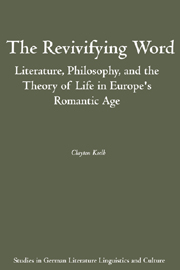Book contents
- Frontmatter
- Contents
- Preface
- Note on Abbreviations and Translations
- Part I Letter and Spirit
- Introduction: “The Dead Man's Life”: Romantic Reading and Revivification
- 1 “The Sound Which Echoes in Our Soul”: The Romantic Aesthetics of Matter and Spirit
- 2 “Spirit Thinks Only Through the Body”: Materialist Spiritualism in Romantic Europe
- Part II The Dead and Living Past
- Part III The Incarnate Word
- Conclusion
- Works Cited
- Index
Introduction: “The Dead Man's Life”: Romantic Reading and Revivification
from Part I - Letter and Spirit
Published online by Cambridge University Press: 05 February 2013
- Frontmatter
- Contents
- Preface
- Note on Abbreviations and Translations
- Part I Letter and Spirit
- Introduction: “The Dead Man's Life”: Romantic Reading and Revivification
- 1 “The Sound Which Echoes in Our Soul”: The Romantic Aesthetics of Matter and Spirit
- 2 “Spirit Thinks Only Through the Body”: Materialist Spiritualism in Romantic Europe
- Part II The Dead and Living Past
- Part III The Incarnate Word
- Conclusion
- Works Cited
- Index
Summary
But how are we to raise the defunct language of Nature from the dead?
— Hamann, Aesthetica in NuceMANY POETS, PHILOSOPHERS, AND SCIENTISTS of Europe's Romantic age struggled to formulate a theory of life that would answer some of the most difficult questions in philosophy. How can we properly characterize and explain the mysterious relation between dead material bodies and living, animate beings? What process causes one to turn into the other? What happens when a living creature ceases to live? And, most puzzling of all, is it possible that life could arise out of lifeless matter? The key that could unlock these mysteries lay surprisingly close at hand: the process by which dead matter could come to life, they imagined, must be something like the process of reading.
In the context of a natural philosophy that suggested the potential presence of life in all material bodies, a novel way of thinking about reading and writing began to develop in the mid-to-late eighteenth century in Germany. Although its basic notions were daring — even a bit alarming — this way of thinking spread steadily across the continent and helped to shape European culture for much of the next century. The new notion of reading was founded upon no less radical a project than the raising of the dead in and through language. Of course I do not mean that the goal of the writers I consider here was to restore life to the dead bodies of actual previously living persons — though their fictional characters sometimes attempted just that.
- Type
- Chapter
- Information
- The Revivifying WordLiterature, Philosophy, and the Theory of Life in Europe's Romantic Age, pp. 3 - 13Publisher: Boydell & BrewerPrint publication year: 2008



